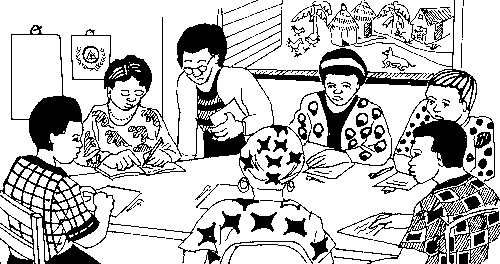Tweet
Translations:
Other Pages:
Modules
Site Map
Key Words
Contact
Utility Documents
Useful Links
FROM LARGE TO SMALL
Learning to read using whole language
by Jacques Slik
Training Handout
The whole language approach
TRADITIONAL READING METHODS
There are many methods in teaching reading.
Some of them are: the sight word method (memorizing words); the phonics method (sounding out letters and words); the controlled vocabulary textbooks (using words that are first learned out of context).
Other reading approaches are combinations of the above reading methods.
These reading methods are contrived and are quite uninteresting to the learner.
These approaches usually start with the smallest component, the individual letters.
They then work on words, sentences, paragraphs, and finally up to articles, stories and books.
In many cases, these are lock-step programs where the student moves along an established and rigid sequence.
WHOLE LANGUAGE APPROACH TO READING
The whole language approach is based on the idea that people learn best when they read for meaning.
It means that the student reads has to come from good literature that is relevant.
Oral language that is generated by the learner is also considered a good source of reading material (please see the section on language experience).
The student must be highly motivated to learn to read.
You can encourage that motivation by showing deep respect for the learner and great enthusiasm in teaching the subject of reading.
The reading material must have high emotional value.
The content must be relevant to the reader’s interests and needs.
The language must be powerful and meaningful!
The whole language approach encourages the learner to read anything and everything of interest.
This could include newspapers, manuals, good books, the Koran, the Bible and any articles that are of interest to the student.
The repeated reading technique can be used to start the student on the road to literacy (please see the document on repeated reading).
Specific lessons about phonics and word recognition can be taught using the reading material rather than isolated lessons.
The whole language approach encourages the practice of learning all the smaller components of reading in context of what the students is reading.
Use excellent stories and poetry to teach lessons in phonics, sight word recognition and sentence structure.
Using textbooks and workbooks is discouraged.
Whole language incorporates many methods of teaching to students to read.
However, ‘reading for meaning’ is emphasized in the whole language approach to reading.
Key Words:
1. Lock-step program – a reading program that is rigid and prescriptive. The teaching material is presented in systematic and sequential manner. All lessons are created in a manner that teachers are forced to follow the strict instructions. There is little room for teacher creativity and initiative.
2. Whole language – a reading approach that encompasses many different ways of teaching students to read. The emphasis of the approach is on reading for meaning using good literature. Whole language is a good example of learning from the “whole to its parts”.
3. Repeated reading – a reading method that requires students to listen to a teacher read a selection and then read the selection after the teacher. Individual and small groups of students can benefit from Repeated Reading. This approach is used as part of the Whole Language reading method.
––»«––
Reading Class
 |